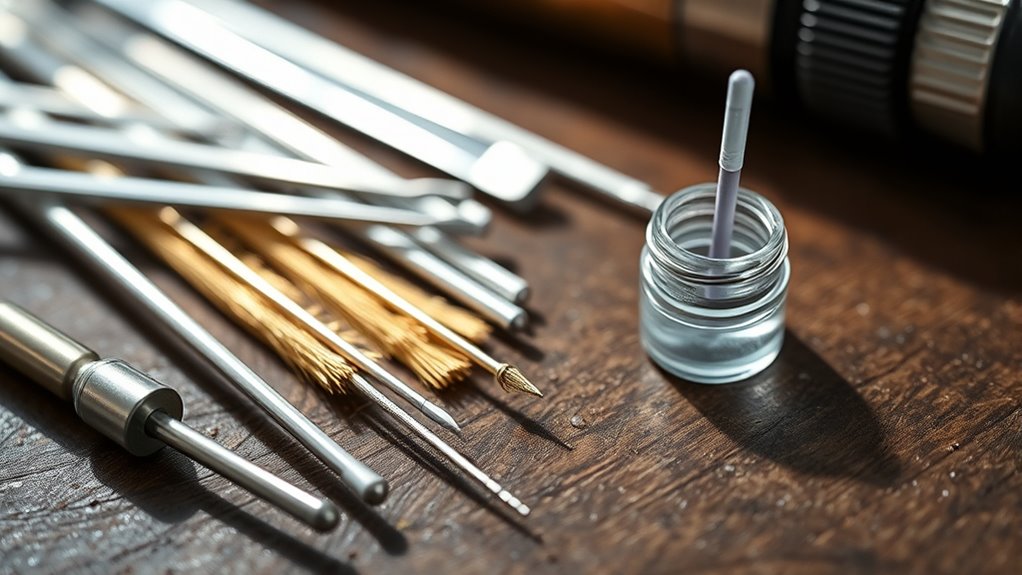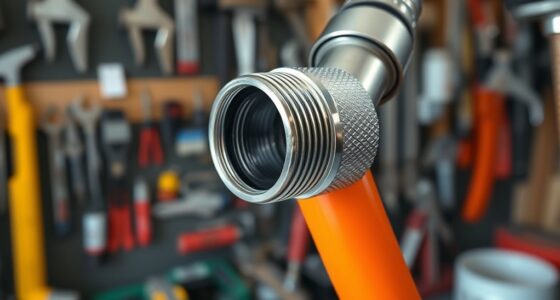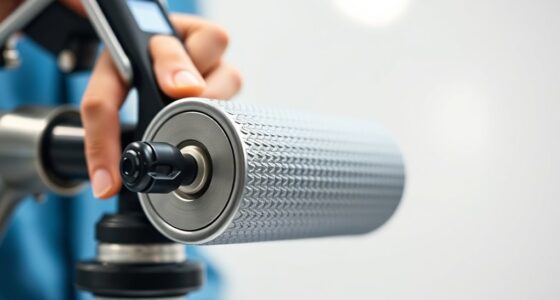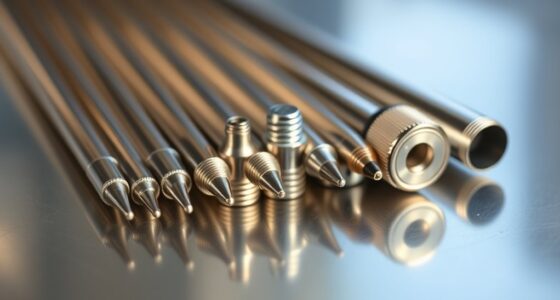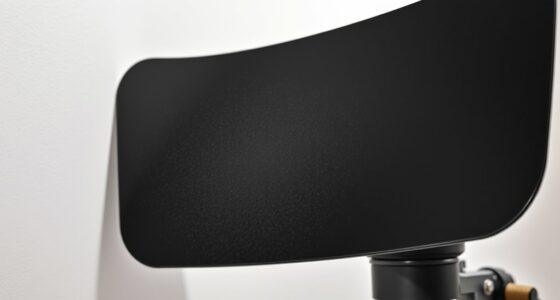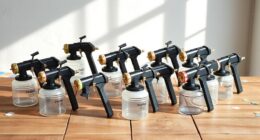To keep your airless spray tips in top shape, use sturdy brushes with nylon or synthetic bristles to clean residual paint and debris thoroughly. Incorporate tip cleanout pins to clear clogs, and consider solvent-based or eco-friendly water-based cleaners for quick, effective dissolving of buildup. Don’t forget to blow out tips with compressed air to remove stubborn residues. Keep your tools in good condition, and you’ll maintain consistent spray quality—stay tuned to learn more essential tips and techniques.
Key Takeaways
- Use dedicated spray tip brushes with nylon or synthetic bristles for effective cleaning without damaging the tip.
- Employ cleanout pins to clear obstructions safely after disconnecting the spray tip from the sprayer.
- Apply solvent-based or eco-friendly water-based cleaners to dissolve dried paint and residues efficiently.
- Incorporate compressed air to blow out debris and residual paint, ensuring a thorough and quick cleaning process.
- Regularly inspect and maintain spray tips using appropriate tools to extend lifespan and maintain optimal spray quality.
The Importance of Regular Tip Maintenance
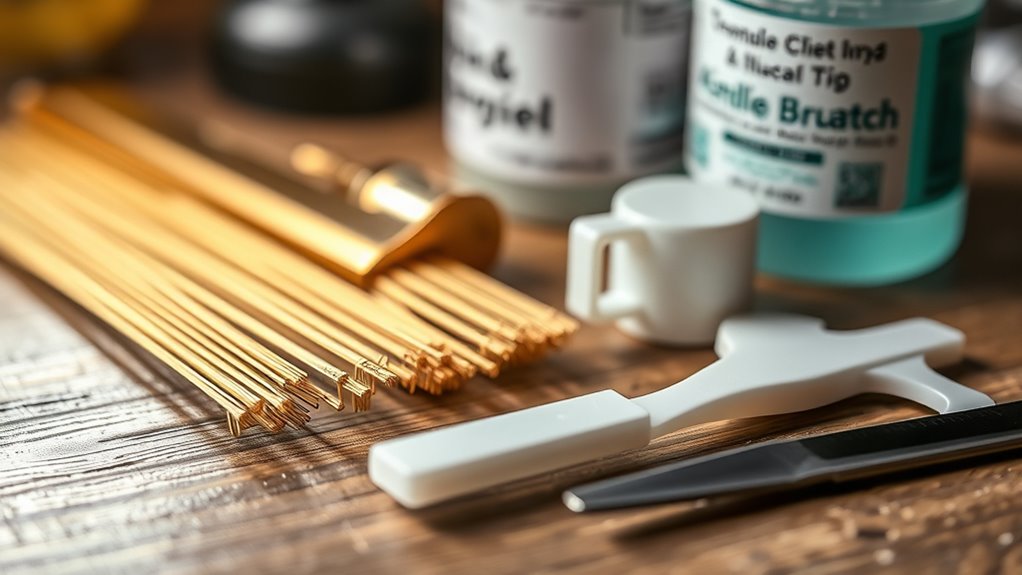
Regular tip maintenance is crucial to guarantee your airless spray equipment performs at its best. When you regularly check and clean your tips, you ensure consistent paint thickness and an even spray pattern. Over time, paint residue can clog the tip, causing uneven flow and compromising the quality of your finish. Maintaining your tips helps prevent these issues, saving you time and effort on touch-ups. Proper cleaning also preserves the tip’s shape, which directly affects the spray pattern—keeping it smooth and uniform. When you stay on top of tip maintenance, you’ll notice improved spray efficiency and a professional-looking finish. Additionally, understanding the performance of electric spray tools can help you choose the right maintenance routine for optimal results. Staying informed about industry trends can also guide you in selecting the most effective cleaning methods. Incorporating regular preventive maintenance into your routine ensures your equipment remains in peak condition and extends its lifespan. Regular cleaning routines are essential for consistent spray quality and to prevent buildup that can impair your spray tip’s performance. Don’t overlook this simple step; it’s essential for achieving the best results with your airless sprayer.
Choosing the Right Cleaning Brush
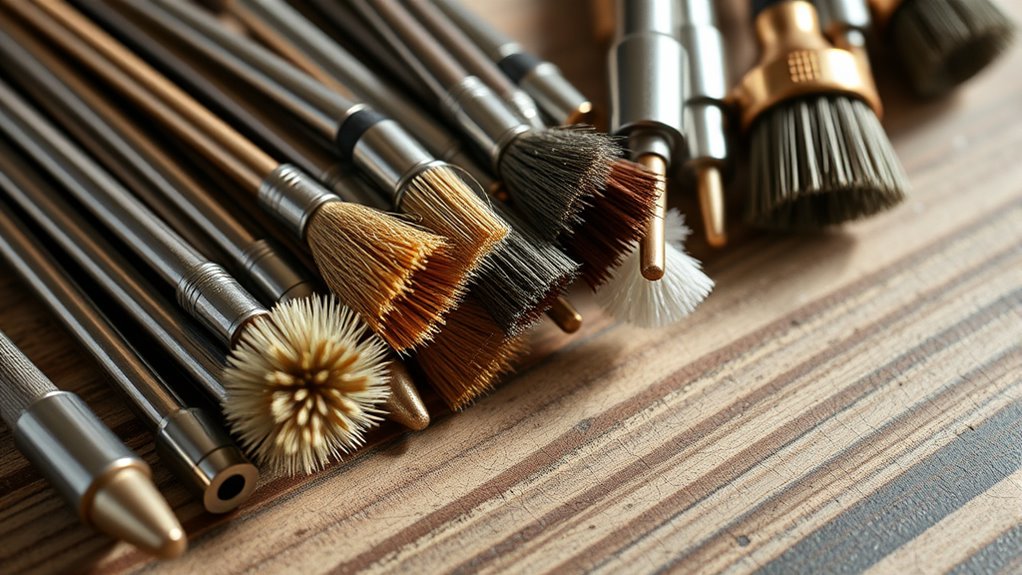
Selecting the right cleaning brush depends on your specific needs, so consider bristle materials that won’t harm your spray tips. Make certain the handle offers a comfortable grip for easier use, especially during prolonged cleaning. Also, verify that the brush size matches your tips to ensure a thorough and effective clean. Incorporating appropriate tools can also enhance your overall maintenance routine for optimal results. Additionally, choosing brushes with durable bristles can help maintain their shape and cleaning efficiency over time. For optimal maintenance, using a proper cleaning solution can effectively remove paint residues without damaging delicate spray components. Understanding cleaning techniques is essential to prevent damage and extend the lifespan of your spray tips.
Bristle Material Options
Choosing the right bristle material for your cleaning brush is essential to effectively remove debris from airless spray tips without causing damage. Bristle durability varies among materials, impacting how long your brush lasts and how well it cleans. Nylon bristles offer good cleaning effectiveness and resist wear, making them suitable for frequent use. Natural fiber bristles, like horsehair, are softer and gentle but may lack durability for tough debris. Wire bristles provide high durability and scrubbing power, ideal for stubborn buildup, but can scratch delicate surfaces if you’re not careful. Synthetic bristles strike a balance between durability and cleaning effectiveness, making them versatile choices. Selecting the appropriate material guarantees thorough cleaning while minimizing the risk of damage to your spray tips. Additionally, understanding the various bristle options ensures you choose the most suitable brush for your specific cleaning needs. Incorporating knowledge of bristle material properties can help you make more informed decisions to optimize your maintenance routine, especially when considering the tuning and performance of your equipment for optimal results. Moreover, choosing high-quality brushes can enhance longevity and ensure consistent cleaning performance over time. For optimal results, consider how bristle stiffness impacts cleaning effectiveness and surface protection.
Handle Comfort and Grip
The handle of your cleaning brush plays a key role in how comfortably and effectively you can clean spray tips. An ergonomic design reduces hand fatigue, allowing you to work longer without discomfort. A textured grip ensures your hand stays secure, even when wet or soapy. When choosing a brush, consider these factors to improve control and reduce strain. The right handle makes cleaning more efficient and less tiring. Here’s a quick comparison:
| Feature | Benefits | Considerations |
|---|---|---|
| Ergonomic design | Fits naturally in your hand, reduces fatigue | Choose a shape that matches your grip style |
| Textured grip | Prevents slipping, improves control | Look for rubberized or ridged surfaces |
| Handle material | Durable, comfortable, lightweight | Avoid brittle or hard plastics |
| Size | Fits comfortably in your hand | Test for proper grip size |
| Overall comfort | Enhances cleaning efficiency | Prioritize comfort over price |
Additionally, selecting a handle with comfortable grip can significantly enhance your cleaning experience by reducing strain during extended use. Incorporating ergonomic features can further optimize your tool for prolonged tasks and minimize discomfort. Considering the material quality of the handle can also impact durability and comfort during repeated use. Properly designed handles are especially important in Louisiana alimony laws and other legal considerations, as ergonomic tools can aid in more precise and less stressful cleaning, similar to how clear legal guidelines help streamline divorce procedures. Recognizing the importance of sustainable material choices can also contribute to environmentally responsible tool selection.
Size and Compatibility
Since the size and compatibility of your cleaning brush directly impact its effectiveness, it’s essential to match the brush to your spray tip’s dimensions and design. Check the spray tip size before selecting a brush to guarantee it fits securely and cleans thoroughly. Using a brush that’s too small may miss debris, while one that’s too large can cause damage or be ineffective. Tip compatibility is equally important; some brushes are designed specifically for certain tip styles or brands. Always verify that the brush you choose is compatible with your spray tip to avoid mishaps and ensure maximum cleaning. Proper sizing and compatibility help you remove clogs efficiently, prolonging your spray tip’s lifespan and maintaining spray quality. Additionally, selecting a high-quality cleaning tool can make the cleaning process more efficient and help prevent damage to your equipment. Being aware of spray tip types and their specific cleaning needs can also assist in choosing the right cleaning tools if you have particular spray tips with unique features. In addition, understanding automated cleaning solutions can offer more efficient maintenance options for frequent users.
Using Tip Cleanout Pins Effectively
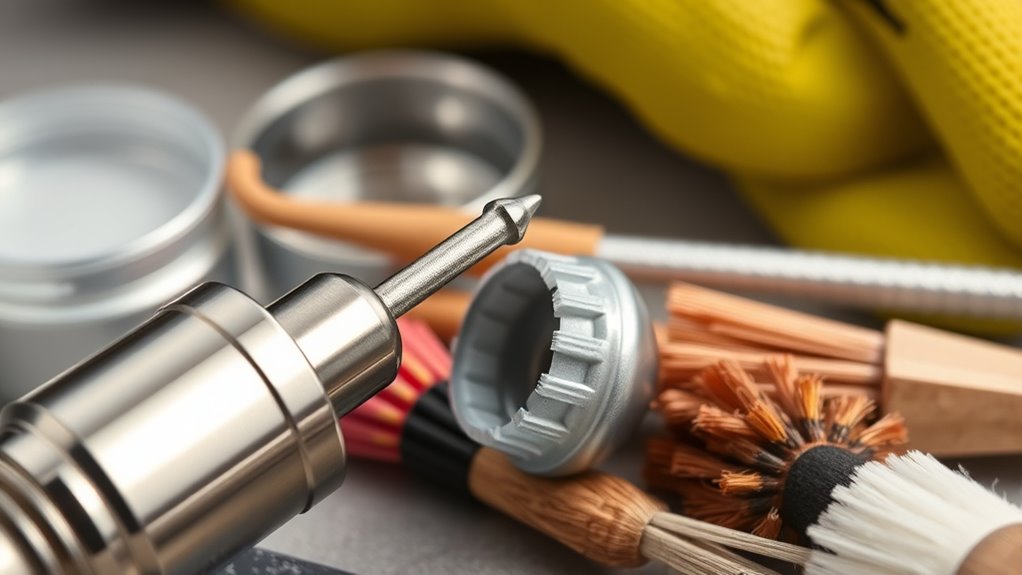
Tip cleanout pins are essential tools for maintaining spray tip performance and preventing clogs. To use them effectively, start by ensuring the spray tip is disconnected from your sprayer. Insert the cleanout pin into the tip opening and gently push through to clear any obstructions. This simple step promotes proper tip cleaning and minimizes the risk of clogging during future use. Always avoid forcing the pin, as excessive pressure can damage the tip or cause debris to lodge deeper. After cleaning, inspect the tip for residual buildup and repeat if necessary. Regular use of cleanout pins keeps your spray equipment functioning smoothly, prolongs tip life, and ensures consistent spray quality. Proper tip cleaning with these pins is a quick, effective method for clog prevention. Incorporating proper maintenance techniques can further enhance your equipment’s longevity and performance.
Benefits of Solvent-Based Spray Tip Cleaners
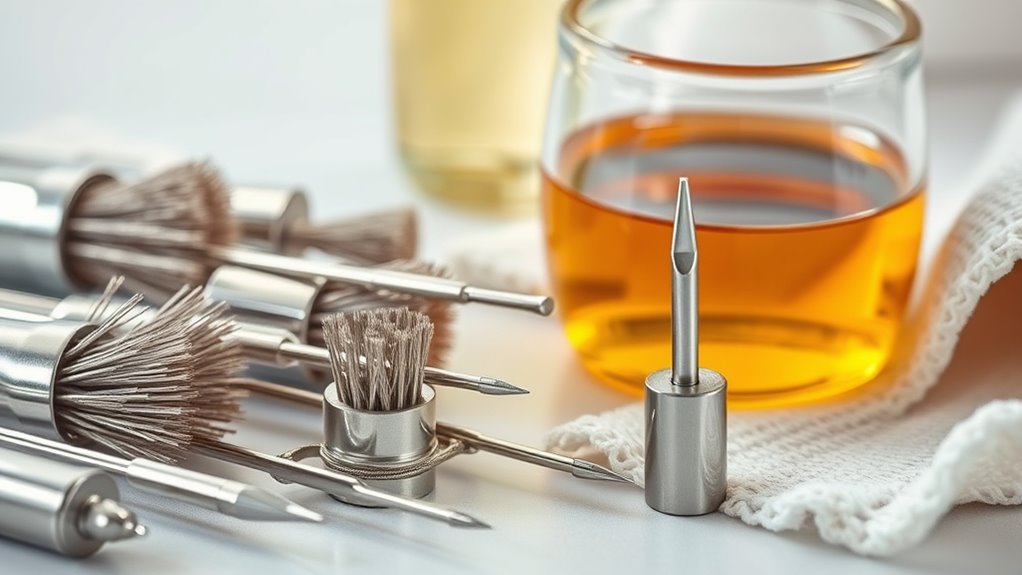
Solvent-based spray tip cleaners are highly effective thanks to their specialized formulations that break down paint and debris quickly. They enable you to clean your tips faster, saving you valuable time on each job. With their powerful action, you’ll keep your spray tips in top condition with less effort.
Effective Solvent Formulations
Effective solvent formulations excel at breaking down stubborn paint residues, making spray tip cleaning faster and more thorough. A well-crafted solvent formulation enhances cleaning efficacy by efficiently dissolving dried paint, grease, and debris that standard cleaners might miss. The right solvent formulation ensures you spend less time scrubbing and more time painting, reducing downtime. High-quality solvents also prevent damage to spray tips and maintain their precision over time. When choosing a solvent-based cleaner, look for formulations that are compatible with different paint types and surface materials. The better the formulation, the more effectively it dissolves tough residues, ensuring your spray tips stay clear and functional. Investing in an effective solvent formulation ultimately saves you effort, improves results, and extends the lifespan of your tools.
Quick Cleaning Action
When time is of the essence, quick-acting spray tip cleaners made with solvents can make a significant difference. They rapidly break down dried paint, guaranteeing your tips are clean in minutes. This quick cleaning action helps maintain ideal paint flow and spray pattern, preventing issues that could affect paint adhesion on your surface. Proper surface preparation starts with clean spray tips, and solvent-based cleaners deliver fast results, reducing downtime between coats. Using these cleaners means you spend less time scrubbing and more time painting, especially when working on large projects or tight schedules. Their efficiency ensures your spray tips stay in top condition, promoting consistent application and better surface finish. Quick solvent cleaners keep your workflow smooth, saving you time and effort while ensuring high-quality results.
Benefits of Water-Based Spray Tip Cleaners
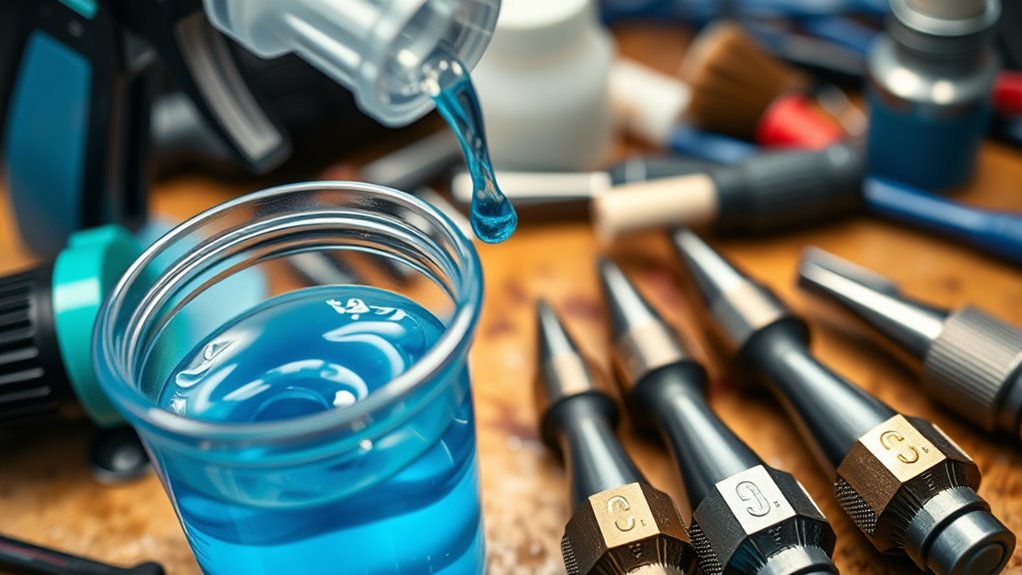
Water-based spray tip cleaners offer several advantages that make them a popular choice for many painters. They typically feature eco-friendly formulations, reducing harmful chemical exposure and environmental impact. This makes them safer to use around your workspace and easier to handle without special precautions. Additionally, water-based cleaners simplify storage and disposal, since they don’t require hazardous waste procedures like solvent-based options do. You can store them in standard containers without concern for fumes or leaks. Disposal is straightforward, often just requiring simple water runoff, which minimizes environmental harm. These benefits not only promote safer working conditions but also reduce cleanup time and costs, making water-based cleaners an efficient, responsible choice for maintaining your spray tips and ensuring optimal spray performance.
The Role of Compressed Air in Tip Cleaning
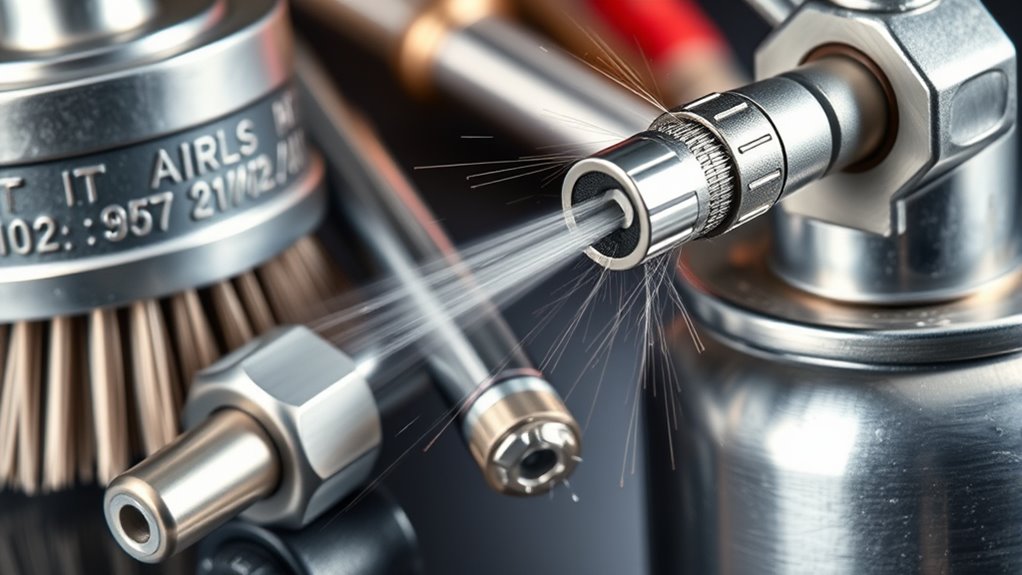
Compressed air plays a crucial role in maintaining spray tip cleanliness by quickly blowing away residual paint and debris that can clog or impair spray performance. Adjusting the air pressure ensures you use enough force to clear stubborn buildup without damaging the tip. Higher pressure boosts nozzle airflow, effectively dislodging dried paint and debris from hard-to-reach areas. Using compressed air allows you to clean the tip efficiently, reducing downtime and maintaining consistent spray quality. Always hold the nozzle close enough to generate sufficient airflow, but avoid excessive pressure that could damage the tip or create safety hazards. Proper use of compressed air keeps your spray tips clean, preserves their lifespan, and ensures smooth, even application during every painting session.
Tips for Preventing Tip Clogs Before Painting
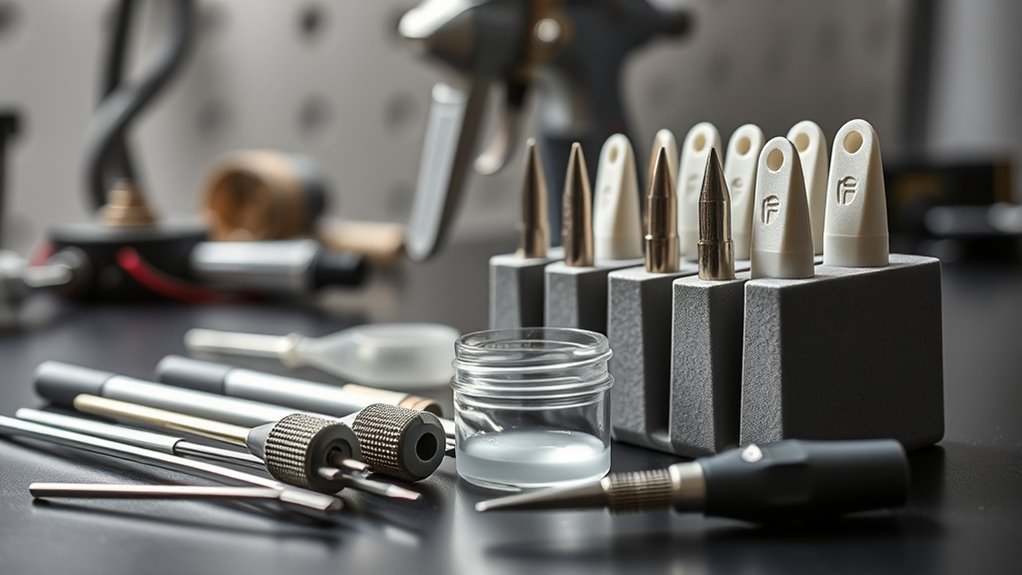
Regularly inspecting and preparing your spray tip before starting a painting job helps prevent clogs that can disrupt your work. Proper paint storage ensures the material remains free of debris and prevents drying inside the tip. Always clear the tip of any previous residue and check for damage before spraying. Follow safety precautions by wearing gloves and eye protection during inspection and cleaning. To further prevent clogs, consider these tips:
Inspect and prepare your spray tip regularly to prevent clogs and ensure smooth painting.
- Store paint properly in sealed containers to avoid contamination.
- Strain paint before loading it into your sprayer.
- Flush the spray tip with a cleaning solution after each use.
- Avoid spraying thick or unthinned paint that can clog the tip during application.
These steps keep your spray tip clear and ensure smooth, efficient painting.
Best Practices for Post-Painting Tip Care
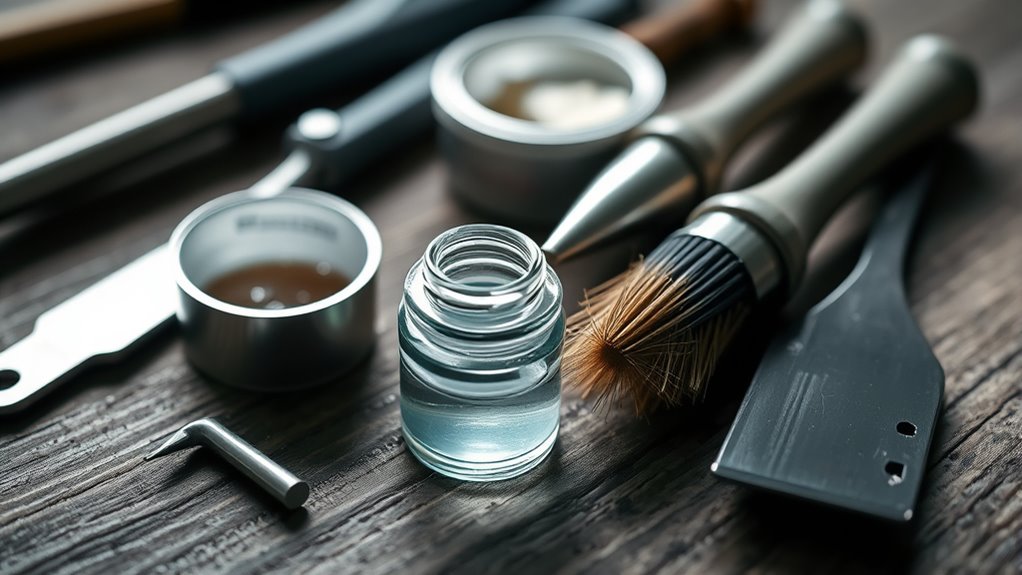
After finishing a painting session, it is essential to care for your spray tip promptly to maintain its performance and longevity. Clean the tip thoroughly with suitable tools to remove residual paint and prevent clogs. Always check your spray equipment calibration before your next project to guarantee consistent paint application. Proper tip care also involves inspecting for wear and replacing worn parts to avoid uneven spray patterns. Remember to store your tips in a dry, clean area, protecting them from dust and damage. Adjust your paint color selection carefully to minimize cleanup. Here’s a quick reminder:
| Step | Purpose | Tips |
|---|---|---|
| Clean immediately | Prevent paint buildup | Use compatible cleaning tools |
| Inspect for wear | Guarantee consistent spray quality | Replace worn tips promptly |
| Store properly | Extend tip lifespan | Keep in a dry, safe place |
| Calibrate equipment | Achieve accurate paint coverage | Regularly check calibration |
Frequently Asked Questions
How Often Should I Replace My Spray Tips for Optimal Performance?
You should replace your spray tips when you notice paint adhesion issues or a changing spray pattern. Regularly inspect for wear, such as clogs or damage, which can affect spray quality. Typically, replace tips every few hundred gallons or after 5,000 to 10,000 spray cycles. Doing so guarantees consistent coverage, smooth spray patterns, and peak performance, preventing uneven paint application and maintaining the quality of your finish.
Are There Eco-Friendly Cleaning Options for Airless Spray Tips?
You’re wondering if eco-friendly cleaning options exist for airless spray tips. The good news is, biodegradable cleaners and natural solvents are effective and gentle on the environment. They break down safely without harming ecosystems, making them ideal choices. By switching to these options, you can maintain your spray tips’ performance while reducing your carbon footprint. Always check product labels to ensure they’re truly eco-friendly and suitable for cleaning spray equipment.
Can Improper Cleaning Damage Spray Tips or Reduce Their Lifespan?
Did you know improper cleaning can reduce your spray tips’ lifespan by up to 50%? When you neglect proper cleaning, tip corrosion can occur, leading to clogged or damaged spray tips. Using harsh cleaning chemicals or scrubbing vigorously can also harm the delicate components, weakening your tips over time. To avoid damage, always use appropriate cleaning tools and gentle methods, ensuring your spray tips stay in good condition longer.
What Safety Precautions Should I Follow During Tip Cleaning?
When cleaning spray tips, you should always follow safety precautions to protect yourself. Wear personal protective equipment like gloves, goggles, and a mask to avoid chemical exposure. Follow proper chemical handling procedures, ensuring you’re in a well-ventilated area and handling cleaning solutions carefully. Never rush the process, and always read manufacturer instructions. These steps help prevent injuries and maintain safe, effective cleaning of your spray tips.
How Can I Identify When a Spray Tip Needs Replacing?
You can tell when a spray tip needs replacing through regular tip inspection. Look for signs like uneven spray patterns, reduced spray quality, or visible damage such as clogs or wear. If cleaning doesn’t restore proper spray quality, it’s time to replace the tip. Maintaining a routine inspection helps prevent clogged or damaged tips from affecting your finish, ensuring consistent application and ideal spray performance.
Conclusion
Regularly maintaining your airless spray tips ensures consistent performance and prevents costly clogs. For example, imagine a painter who neglected tip cleaning, leading to uneven spray and delays. By choosing the right tools—like solvent cleaners and proper brushes—and adopting best practices, you can keep your tips in top shape. A little routine care not only saves time but also extends your equipment’s lifespan, making every project smoother and more efficient.
